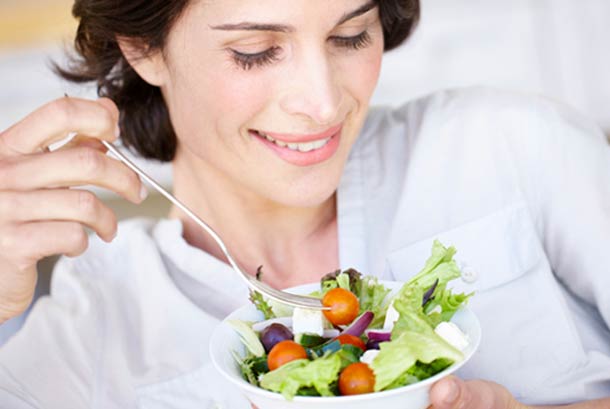Healthy eating is all about choosing those foods that provide the most nutrients and eating them in the right amounts.
Nutrient-dense choices are typically foods that are closest to their natural (or whole) state, including fruits, vegetables, eggs, nuts, whole grains and lean proteins. They also have little or no solid fats, sugars or refined starches, as these “empty” calories are best eaten in moderation or avoided altogether.
A woman’s nutritional needs change over the course of her lifetime. Following is an overview of some of the nutrient-dense foods to choose at different times in a woman’s life:
The teenage years
Establishing healthy eating habits now can be an important factor in keeping some of the chronic conditions of adulthood at bay.
While osteoporosis is usually found in older women, getting plenty of calcium and vitamin D during the formative years will help build strong bones and decrease the risk of developing osteoporosis later in life.
Bone-building choices: Plenty of dairy, especially choices that are fat-free or low-fat, including milk, yogurt and cheese.1
Teenage girls who experience heavy bleeding during their periods may be at risk for iron-deficiency anemia. It’s important to ensure that iron-rich foods are part of their diet.
Iron-rich foods: Red meat, tuna and salmon, eggs, beans, leafy green vegetables, and foods that specify that they are fortified with iron.2
Teenage girls sometimes avoid fatty foods so as not to gain weight, but some healthy fats are essential for good health.
Good fats: Salmon, olive oil and avocados.3
Before and during pregnancy
Women who are expecting will want to consult with their physician about their specific nutritional needs. They are likely to need a daily prenatal vitamin and will have calorie needs that are different from those of women who are not pregnant.
Women of childbearing age also need sufficient folic acid, both before and during pregnancy, to help prevent certain birth defects.
Folate-rich foods: Spinach and other dark, leafy vegetables, oranges and orange juice, nuts, beans, poultry and whole grains.4
Middle age and beyond
During this time, it becomes increasingly important to eat for health. Certain chronic conditions, like diabetes and heart disease, are less likely to occur in those who maintain a healthy weight, eat with a focus on wellness and lead an active life.
Getting plenty of fiber helps to minimize stress and keep hunger in check. High-fiber foods may also decrease the chance of getting colorectal cancer.
High-fiber foods: Beans and peas, nuts and seeds, fruits, vegetables, oats, wheat bran and whole grain foods (such as brown rice and whole grain breads, cereals and pasta).5
According to the Centers for Disease Control and Prevention, heart disease is the leading cause of death for women in the United States. An unhealthy diet can affect a person’s blood pressure, glucose levels, arteries and more.
Heart-healthy choices: A variety of fruits and vegetables, whole grains, low-fat dairy products, skinless poultry and fish, nuts and legumes, and non-tropical vegetable oils.6
Chronic diseases can become more prevalent with age. Time and time again, inflammation has been shown to be one of the primary reasons behind pain and disease. Chronic inflammation can go unnoticed for years. It can cause serious problems down the road such as osteoarthritis, Lupus, Crohn’s and various cardiovascular diseases.
Inflammation-fighting foods: Fruits, vegetables, soy, nuts, extra virgin olive oil, fatty fish and whole grains.7
Eating for health doesn’t have to be about deprivation. Stay in-the-know about what’s best for a woman’s body at different times of her life and focus on nutrient-dense foods that are enjoyable and good for you, too.
Sources:
1U.S. Department of Agriculture
2U.S. Office on Women’s Health
3Office on Women’s Health
4Office on Women’s Health
5Food and Drug Administration
6The American Heart Association
7Today's Dietitian, Sunrise Senior Living, Aging Care, Arthritis Foundation

